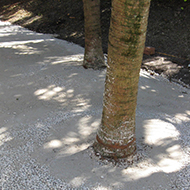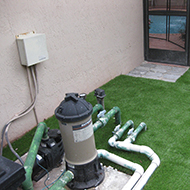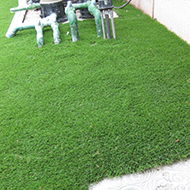Before installing artificial grass you need to have the right tools for the artificial turf project. It is important to understand what each tool’s function is and how it works for your artificial grass installation. For most tools you can contact a tool rental company to rent the equipment, but most can be found and purchased or rented from your local home improvement stores. In many cases power tools can be substituted with hand tools, they may help make the process easier and more efficient. Below is a listing of all the tools applicable to synthetic grass installation.
Sod Cutter, Shovel, Hoe, Wheelbarrow, Measuring Tape, Spray Paint or Chalk Line, Landscape Rake, Broom, Fertilizer Spreader, Plate Compactor or Vibratory, Hand Roller or Plate Tamp, Trowel, Carpet Cutting Knives or Razor Knife, Trimming Shears, Roof Flashing, Seam Tape or other seaming solution, Glue, Carpet Kicker, Hammer, Staples, Nailer boards or 60 (D) “Pole-Barn” Nails.
In order to determine the best size and shape design for installing artificial grass, you have to keep in mind that all the artificial turfs are 15 FEET WIDE and up to 100 ft. long. Artificial turf can be seamed together to create larger widths. The idea is to have the fewest amounts of seams as possible. Multiply the areas width and length based on 15 foot width rolls. This is how much turf you will need for your area. Your turf order should always be 15 foot wide by your determined lineal (Length) feet. Please make sure you allow for extra turf for any trimming and seaming. Please make sure that you measure at least twice and review your measurement with an Artificial Turf Supply specialist. Additionally, the turf weighs about one half pound per square foot. To determine the weight of your artificial turf roll; divide the total square footage of each roll in half. For Example 750 sq. ft. divided in half is 375 Pounds. NOTE: Artificial Turf comes in a roll on a carpet core.
For most borders you can use nailer board, bender boards or your imagination. Some synthetic grass installation contractors have folded the turf over onto itself but this is not recommended in most cases. Make sure to take note of the borders of where the turf will go and determine which curbing you will use and what edging techniques will be applied. If you are planning on installing artificial turf with any edging, curbing or borders, please install prior to cutting the turf in order to get a more precise measurement. If there is existing curbing or edging make sure that you measure perfectly in between the inside area of each of the borders.
Some edging or bordering options that will enhance the appearance of your synthetic grass installation application are to add a nice frame around the turf: Curbing, decorative rock, mulch and bender boards are several ideas that will work nicely.
If your installation of artificial turf is going around trees, bushes, or any utilities such as light poles and air conditioning units, you must mark around these areas in order to account for the turf edges. Typically you should allow a 6″ radius area uncovered around the bases of any trees, bushes and structures.



WARNING: Please check for any wells or electrical that may be located in project area.
Check your area for irrigation heads. Once identified, be sure to cap them off or have them removed.
Because the artificial turf is directional, you must make note of the fibers directions (grain). Determine which direction you will roll out your turf and how the turf will be laid down and seamed. Most artificial grass installation projects tend to face towards the viewer’s perspective. If possible, you must always apply the turf with the fibers of the turf against the slope of your application area. Once you have made your decision on what direction your turf will go make sure to always run the fibers in the same direction. If you do not lay the turf, with the fibers going the same direction, the seams of your project will stick out and be too obvious.
Now that we have our tools, design, bordering, turf direction and structures in mind we can begin the process of selection which turf you will use for installing artificial grass. Typically for a residential and commercial application, Artificial Turf Supply recommends a turf model from 40 ounces to 90 ounces per square yard of face weight. These artificial grasses are extremely durable; dual thatched and will make for an easy synthetic grass installation. Infill is always recommended to enhance the appearance, reduce surface temperature, allow the artificial turf blades to stand up, emulate the feeling of soil, handle light to heavy traffic, add extra cushioning for an impact zone, prevent mold and mildew, and increase the overall wear of your artificial turf system.
This guide is for the individuals or contractors and turf installers who wish to install their Do It Yourself artificial grass turf project. Artificial Turf Supply makes no representations or warranties regarding the following installation information. This guide is a best effort to installing artificial grass yourself and is not intended for some other specialized artificial turfs, not all results are guaranteed.
Free quote, no strings attached.
Artificial Grass is Our Specialty